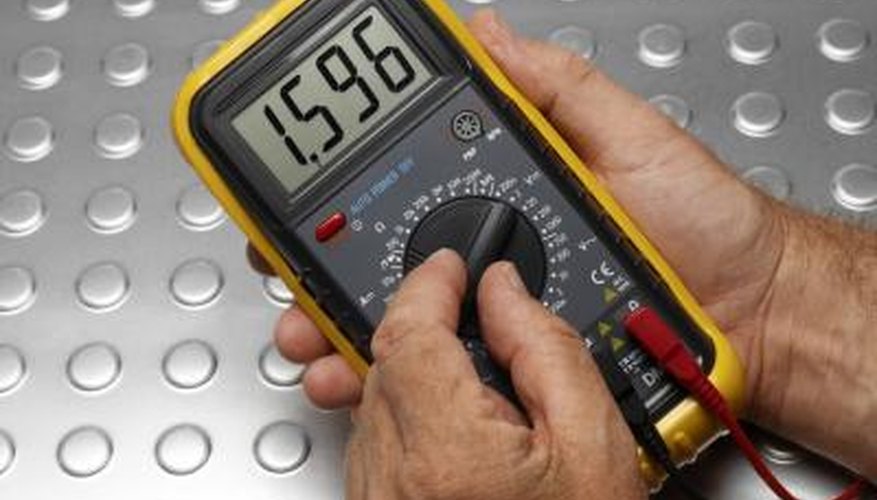Lithium ion (Li-Ion) batteries have increased in popularity. They produce 3.6 volts compared to 1.2 volts from nickel-based batteries while lasting longer. One of the main advantages is fewer batteries are needed to power your electrical devices, which gives about a 40 per cent saving in weight and makes battery packs more compact -- particularly useful if you are a remote control aeroplane enthusiast. It's best not to fully discharge Li-Ion batteries as this can damage them. To help prevent over discharging, the batteries are preset to stop operating when the energy level gets to 5 per cent. Using a multimeter to test your battery's energy level ensures you know when to recharge it.
Note the output voltage of the Li-ion battery from the label on the battery or battery pack by writing it on a sheet of paper. This will allow you to test the voltage your battery actually has compared to what it should produce when fully charged. Each Li-Ion cell produces 3.6 volts, but if you have a Li-Ion battery pack, there are several batteries wired in series, increasing the output voltage depending on the number of Li-Ion cells in the pack. For example, if your battery pack has an output of 14.4 volts, it contains four cells.
- Lithium ion (Li-Ion) batteries have increased in popularity.
- Each Li-Ion cell produces 3.6 volts, but if you have a Li-Ion battery pack, there are several batteries wired in series, increasing the output voltage depending on the number of Li-Ion cells in the pack.
Note the milliamp hours (mAh) your Li-Ion battery or battery pack produces when fully charged. You can find this on the battery label. This information is useful as it determines how long you can expect your battery to last.
Turn on your multimeter and set it to measure voltage. Place the sensors on the end of the two wires from the meter onto the positive and negative terminals of your Li-Ion battery or battery pack. The battery terminals are labelled "+" and "-" respectively and the wires from the meter are coloured red and black, meaning positive and negative respectively.
Check the voltage reading on the multimeter and make a written note of it, then remove the sensors from the battery terminals. The reading should be the same as the voltage you made a note of from the Li-Ion battery label if the battery is charged. The reading may be slightly higher than the label if you have fully charged the battery recently. Li-Ion batteries are able to maintain a constant voltage during most of the discharge process so even if the battery is 50 per cent discharged, the reading is likely to be only a little lower than the voltage on the battery label. However, if the voltage from the meter reading is more than 20 per cent lower than the voltage on the battery label, you need to recharge your battery.
- Note the milliamp hours (mAh) your Li-Ion battery or battery pack produces when fully charged.
- However, if the voltage from the meter reading is more than 20 per cent lower than the voltage on the battery label, you need to recharge your battery.
Change the setting on your multimeter to measure mAh. Repeat the procedure by placing the sensors on the end of the wires from the multimeter onto the battery terminals as before.
Read the multimeter display and make a written note of the figure. It should read the same as the mAh you noted from the battery label earlier if your Li-Ion battery is fully charged. Remove the sensors from the battery terminals and turn off the multimeter.
Check the label on your device to ascertain the mAh rating your device uses. Make a written note of the figure.
- Change the setting on your multimeter to measure mAh.
- Check the label on your device to ascertain the mAh rating your device uses.
Calculate the percentage charge in your Li-Ion battery using a calculator. Divide the mAh figure you noted from the multimeter by the figure from the mAh figure from the battery label, then multiply by 100 to find the percentage charge. For example, if the meter reading is 800 mAh and the battery label says 1,000 mAh, 800 divided by 1,000 equals 0.8, which multiplied by 100 equals 80. Therefore, your battery is 80 per cent charged.
Calculate how long your Li-Ion battery is likely to power your device before it needs recharging using a calculator. Divide the mAh figure you noted from the meter by the mAh figure you noted from the label on your device; the result is the time you can expect your battery to power your device. For example, if the mAh on the meter is 800 and the mAh you noted is 200, then 800 divided by 200 is 4, meaning your battery will last about four hours.
- Calculate the percentage charge in your Li-Ion battery using a calculator.
- Divide the mAh figure you noted from the meter by the mAh figure you noted from the label on your device; the result is the time you can expect your battery to power your device.
